VIA's Dual Core Nano & VN1000 Chipset Previewed
by Anand Lal Shimpi on November 15, 2010 12:26 PM ESTGraphics Performance: Surprisingly Potent
Preparing to test the VN1000 was a lot like deciding to go see a John Cusack movie. You assume it’s going to be bad, but every now and then you might be pleasantly surprised. My expectations were thus very low.
The last VIA platform I had wouldn’t complete most 2D benchmarks in Windows 7 due to driver issues and general instability. That’s why you only see a few scores from the old Nano in Bench. The VN1000 was completely different.
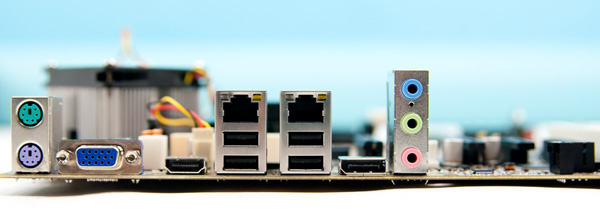
The VIA VN1000 Reference Board featured VGA, HDMI and DP outputs
Despite the typical omg-thisisntATI/NVIDIA error that some games always throw, the VN1000 actually ran everything I threw at it. I didn’t notice any rendering errors or any driver compatibility problems. I didn’t run every last title on the market, but I ran a number that I honestly didn’t expect VIA to be able to handle. And the VN1000 did.
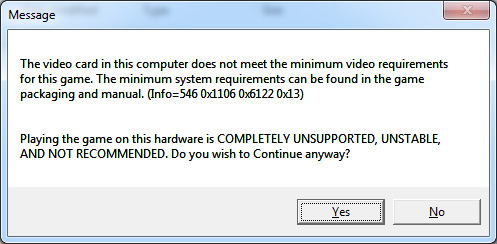
Dragon Age, Modern Warfare 2, BioShock 2, World of Warcraft and even Starcraft II all ran on the VN1000. Not only did they run, but some of them actually ran pretty well.
As with all integrated graphics I had to test at the lowest possible quality settings at 1024 x 768 across virtually all titles. I should add that although the Chrome 520 GPU does support H.264 acceleration, I couldn't get it working with the driver drop I had on my test platform. CPU utilization would be low but I still dropped frames. I suspect this is a driver or software compatibility issue which I do expect VIA to rectify before the platform ships.
First let’s compare directly to Atom and ION:
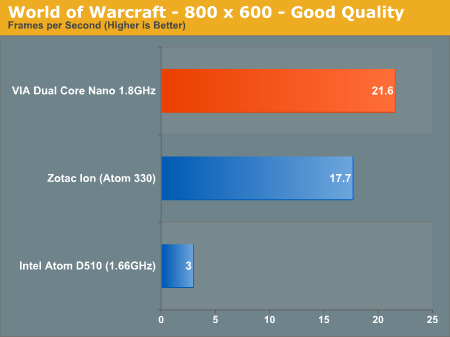
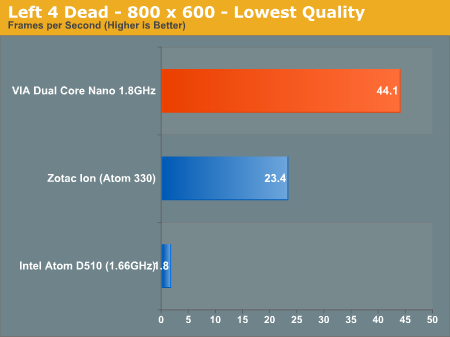
The Atom comparison is dramatic. Intel hasn’t taken GPU performance seriously for years and Atom was the last example of that mentality. What’s even more surprising however is that the Chrome 520 GPU is actually faster than NVIDIA’s ION.
Clearly the VN1000 can hold its own in the Atom space, so let’s set our sights a little higher. How about Clarkdale?
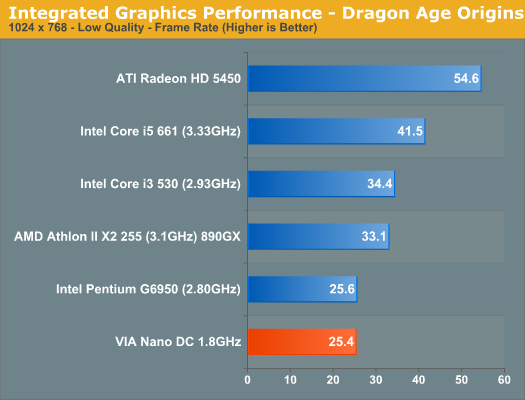
Under Dragon Age Clarkdale puts VIA in its place. The Core i3 manages a 40% performance advantage here. But look at a lower end competitor: the Pentium G6950 is no faster than the dual core Nano/VN1000 platform!
It gets even more ridiculous under Modern Warfare 2:
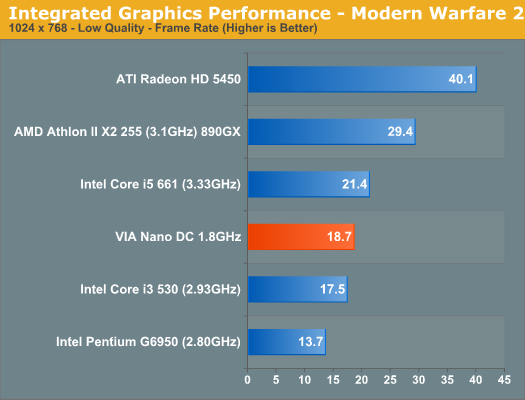
VIA’s platform is actually faster than Intel’s Core i3 with integrated graphics. The same holds true under World of Warcraft:

Here the Nano is able to even equal the performance of the Core i5 661. Pretty impressive.
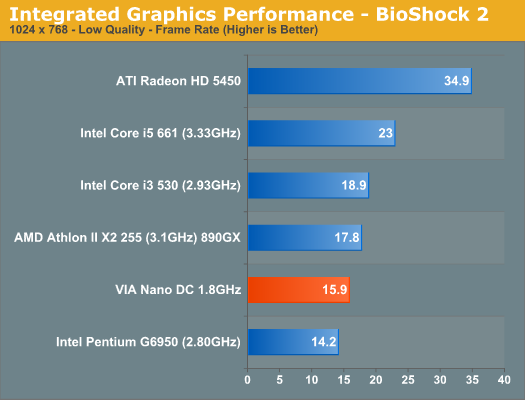
The VIA platform didn't handle BioShock 2 very well, but it's still able to get the Pentium G6950 a run for its money.
I was particularly curious to see how Starcraft II ran on the platform. Starcraft II can be both GPU and CPU limited within a single play session simply depending on what you're doing. Scrolling around the map and just watching your units gather resources tends to be GPU bound on mainstream or faster systems. Big battles however are almost always CPU bound. To showcase both we have two benchmarks. Our GPU test is a 2v2 with a lot of scrolling around the map, while our CPU test is a 3v3 monitoring frame rate during a huge battle involving all of the players.
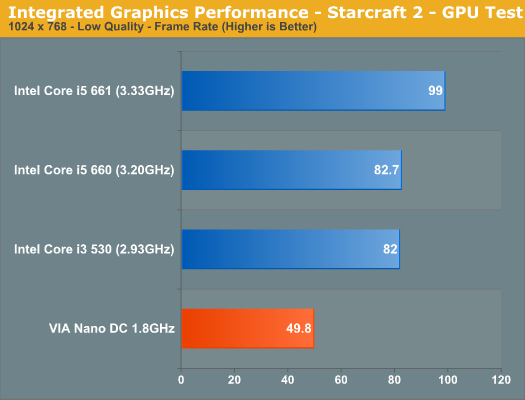

VIA's Chrome 520 is definitely fast enough for Starcraft II. At low quality settings, the VIA platform can manage nearly 50 fps in our GPU test. That translates into smooth gameplay while moving around a map and selecting units. It's the CPU that's holding back the platform. In large battles the Nano DC drops down below 10 fps and choppiness ensues. Intel's Clarkdale graphics enjoys around 2x the performance in our CPU test and about 60% higher frame rates in the GPU test. Intel has done a lot of work with Blizzard optimizing for SC2, so strong performance here isn't surprising.
Overall, you can color me impressed. This is real world, usable performance. Even the experience under Windows wasn’t half bad. Moving windows around was sometimes choppy but for the most part it could’ve been any other integrated graphics platform that I was using. Drivers installed fine and I didn’t get any strange crashes or compatibility errors during my limited testing period.
I have to say that this is probably the first VIA platform that has delivered not only competitive but impressive graphics performance in years. Let’s take a look at the CPU performance.










54 Comments
View All Comments
East17 - Tuesday, November 16, 2010 - link
AMD delivered and even exceeded their promises with Zacate. It's a very good solution that mops the floor with Atom and sometimes, especially when IGP is involved, mops the floor even with Core i3 that is a CPU much more expensive with an expensive platform. What's amazing is that Zacate's best competitor is not Intel Atom but VIA's Nano & VN1000 chipset. Congratulations to both AMD and VIA. I think they should really take over the "power efficient market" and just banish INTEL with its expensive, low quality and low performance part.chukked - Tuesday, November 16, 2010 - link
can anyone please tell me why can not nvidia take over via and make their own x86 cpu? as via has right to make x86 cpu.UrQuan3 - Friday, November 19, 2010 - link
I want to thank Anand for testing video playback on the platform. It's entirely too often that only encoding is tested. If I have a htpc, playback is all I really care about. If Via gets that working, I'll be buying one. If not (like the last 4 Via chipsets) it's a no go. In my experience, the Nano can only handle 720p playback in software.General.TerroR! - Saturday, November 20, 2010 - link
Things would have a bit more interesting, if there was an inclusion of the similarly clocked Atom D525 @ 1.8 GHz, in all the tests.